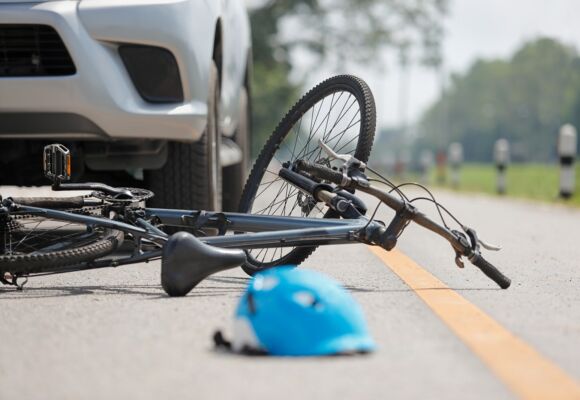According to a government report, in 2021, 111 pedal cyclists were killed, 4,353 were seriously injured, and 11,994 were slightly injured in accidents. That’s an estimated 84 cyclists injured per week.
So, if you’ve been injured in a cycling accident that was not your fault or where a person owed you a duty of care, you may be entitled to claim compensation for your injuries. Whether those injuries are the result of another driver, cyclist, pedestrian or road user, it is possible to recover losses that include:
- Pain and suffering
- Loss of earnings
- Cost of care of assistance
- Treatment costs
- Damage to property
- Incidental expenses
- Policy excess
You can make a compensation claim with the support and guidance of an expert personal injury solicitor like ours at Waldrons Solicitors.
What to do after the accident?
These are important steps you can take which may help the claim run more smoothly:
Helpful tips:
- Obtain the driver’s details; you’ll need their registration number and their insurance details. The registration number is the most important piece of information.
- Obtain the contact details of any witnesses to your accident.
- If it is safe to do so, take photographs and videos of the scene, including vehicle positions, road markings, fixed landmarks like road signs and evidence of what you are wearing. Proof that you were visible helps your claim.
- If you have a head cam or vehicles involved have a dashcam, obtain that person’s details so you can access the footage.
- Report the incident to the police as soon as possible.
- Keep a record of any medical treatment you receive.
- Keep a record of your account of the accident.
- Keep receipts for expenses, including bike repairs or replacement parts.
- If you have had to replace the bike from the accident, ensure you keep the original bicycle, even if it is severely damaged, as this is vital evidence. You may be unable to recover the replacement cost without evidence of the damage to your original bike.
- Keep damaged items such as clothing and protective gear. Insurers may want to inspect these before making payment to you to repair or replace the damages items.
- Take photos of damaged items, as this will support medical evidence. They could, for example, demonstrate where the impact occurred and the severity of your injury.
Cyclists’ rights on the road
In 2022, there were significant changes to the rights of cyclists using UK roads, all of which are in the Highway Code. You must also consider the list of recommendations made in Annex 1. Understanding your rights can help to understand the likely outcome of your claim.
- Hierarchy of road users: Cyclists have the right of way over vehicles, but pedestrians have the right of way over cyclists.
- Priority at junctions: Cyclists should give way to pedestrians waiting to cross the road at a junction or zebra crossing. Drivers should not cut across cyclists; this applies when using a cycle lane, track or on the road.
- Parallel crossings: All other road users must give way to pedestrians and cyclists.
- Overtaking: Drivers should be at least 1.5 metres away when overtaking at speeds of 30mph.
- Opening car doors: Drivers should use ‘the dutch reach’ when opening doors, using their hand opposite the door to open it.
- Group riding: Cyclists can ride two abreast but should be aware of vehicles. Allow them to overtake when safe to do so. Cyclists should call out to alert others.
- Road position: Cyclists should ride in the centre of the lane and move to the left to allow vehicles to overtake when safe.
- Cycle lanes: Cyclists have the right of way on cycle lanes but are not obligated to use them.
- Crossing in front of drivers in slow-moving traffic: Drivers should allow cyclists and pedestrians to cross in front of them.
- Stop lines: Cars should allow cyclists time and space to move when the green signal shows.
- Roundabouts: Cyclists have priority.
- Your bike must have two functioning brake systems.
- You must be visible to other road users and wear the appropriate clothing or a headlamp.
- Riding a bike with a helmet is advised but not mandatory.
- At night your cycle must have white front and red rear lights lit.
- Your bike must be fitted with a red rear reflector, a white front reflector, amber reflectors on your pedals and spoke reflectors.
- Cyclists are not obliged to use cycle lanes and may exercise their judgement.
- You must keep to the side intended for cyclists on cycle tracks.
- Do not pass pedestrians, horse rides or horse-drawn vehicles closely or at high speed, particularly from behind.
- Do not pass horse-drawn vehicles, moving traffic or long vehicles on the left.
- You must not cycle on the pavement.
- Do not pass between the curb and a bus when it is at a stop.
- You must not carry a passenger unless your cycle is adapted to do so.
- You must not hold on to a moving vehicle or trailer.
- You must not ride in a dangerous, careless or inconsiderate manner.
- You must not ride when under the influence of drugs, including medicine.
- You must obey all traffic signs and light signals.
- You must avoid crossing the stop line when at traffic lights.
- Do not ride across a pelican, puffin or zebra crossings. Dismount and wheel your cycle across.
- You must not cross toucan crossings until the green symbol is showing.
Contact Waldrons Solicitors
Here at Waldrons, we have a team of experienced personal injury solicitors who can help you Contact us today to discuss your circumstances.
More information on Cycling Accidents
